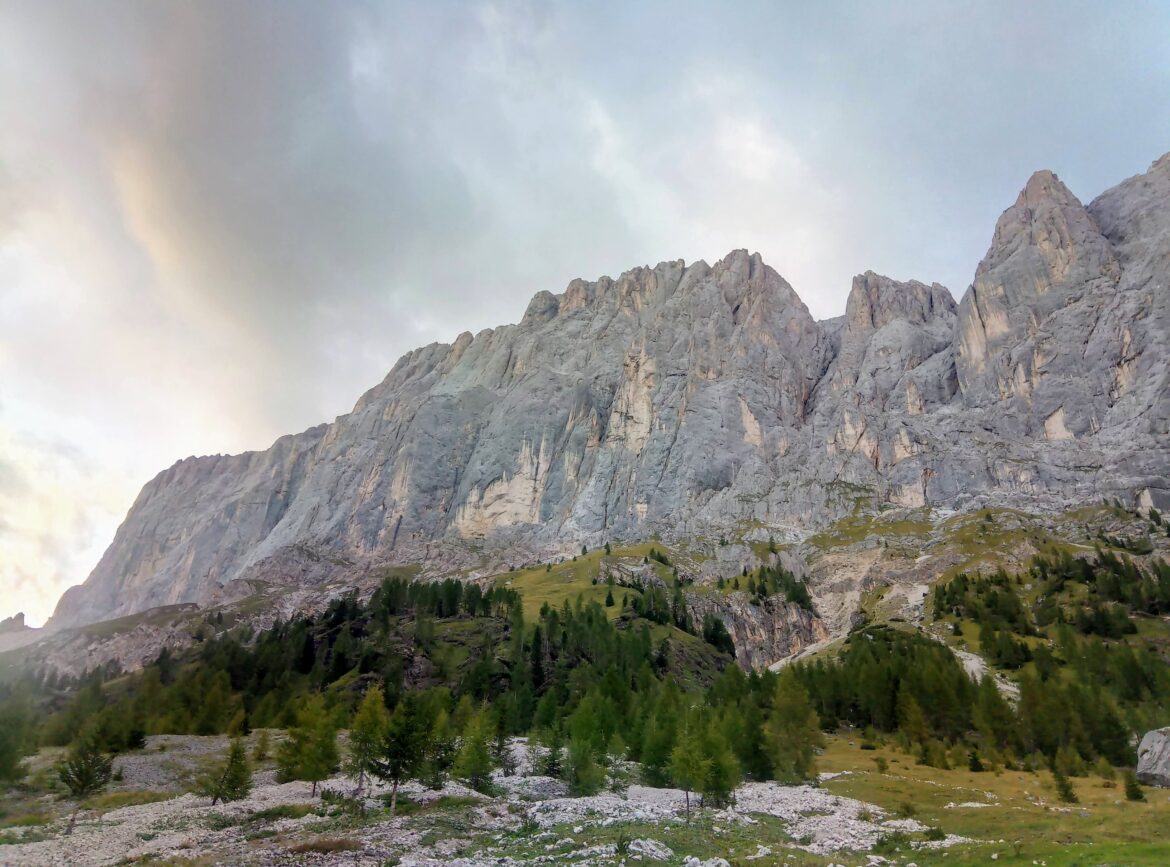The doors of the C3 are wide open and our belongings are piled up happily in the car park of the small village of Malga Ciapela, at the foot of the Queen of the Dolomites, the Marmolada.
It's the beginning of our Italian roadtrip, the organization is slowly coming together and for the moment, every time we need a carabiner, we have to take out three bags to get it. We designate one door per area of activity: the left for the bivouac and clothing, the right for food and finally, the trunk for climbing and free flight equipment.
For this first ascent of the trip, we carefully prepare our things. Everyone takes their personal climbing and bivouac equipment and we share the rest of the common equipment as well as our supplies of water and food for two days. Everything more or less manages to fit in a light 40-litre bag, and we embark on the approach walk, in the direction of the Rifugio Falier. The trail is pleasant, around us the forest clings to the steep slopes of a deep canyon. Many trees, mostly softwoods, are down in whole sections, suggesting that a terrible storm swept through the area maybe two or three years ago.
We set foot on a vast plateau made up of green meadows streaked by a stream that invites tranquility. And then, looking up above the treetops, the imposing southern wall of the Marmolada finally reveals itself to us. Several kilometers long and about 1000 meters high, it is breathtaking, but does not seem as steep as its reputation might suggest. We realize very quickly that this is a problem of perspective, or a strange low-angle effect. Our mind does not yet manage to imagine the massive entirety of these walls, the size of the walls being disproportionate to anything we have encountered before. However, this has the beneficial effect of giving us confidence in our plans for future climbs.
We want to confront the Vinatzer route of 1936 by taking the exit variant opened by Reinhold Messner in 1969. The famous mountaineer had made an impression at the time because he had opened this direct line alone, refining the work with class of its illustrious predecessor on this side.
Giovanni Battista Vinatzer is a little-known climber in the French Alps. However, like many of his Italian compatriots, he was a precursor for the purity of the lines he found on virgin faces, and which he climbed in a style close to modern free climbing. Tomorrow, 900 meters of verticality await us, rather homogeneous around 6a/6b, to exit on Punta Rocca at 3309 meters above sea level.
Behind us the sun begins to set and a gap in the crowded sky lets us see a monstrous rock face that seems to float above the clouds.
“It's the north face of the Civetta! »
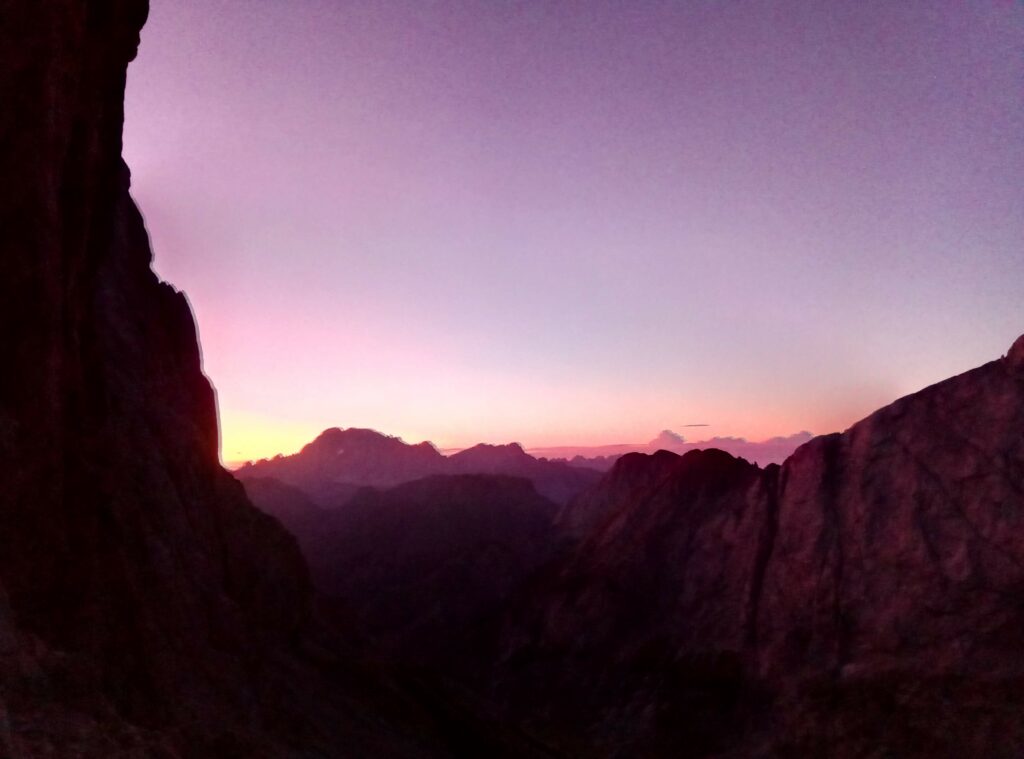
This incredible mountain whose tapering peaks exceed 3000 meters in altitude is also on our list, but the commitment and its reputation as a North face make it a much more delicate and uncertain challenge. We are relatively late in the season, and it is probably not certain that such a project will be feasible this year, unless there is a good weather window perhaps...
We find an excellent bivouac site above Rifugio Falier and take the time to install our survival blanket on a flat space protected from humidity by a large balanced block. We do stretching and yoga facing the beautiful valley covered a little earlier. As usual with Max, the jokes are going well, the atmosphere, like the weather, is fine. After a quick dinner, a barely bearable coolness envelops us and we sink with satisfaction into our respective duvets. A little nervousness prevents me from falling asleep immediately. I remember that night, a few years ago, when I was finishing Tita Piaz's book, The Devil of the Dolomites, I was haunted by the images of these towers and these legendary limestone walls and I couldn't close my eyes. I had to roam the web looking for a topo on the Dolomites, which I immediately ordered to finally find rest. A few months ago I still did not feel capable of facing them. I had neither the level nor the experience in traditional climbing necessary to think of a confrontation with these vertical kilometers. Then, there was the meeting with Max and our summer of intensive climbing in the Alps which came to change the situation.
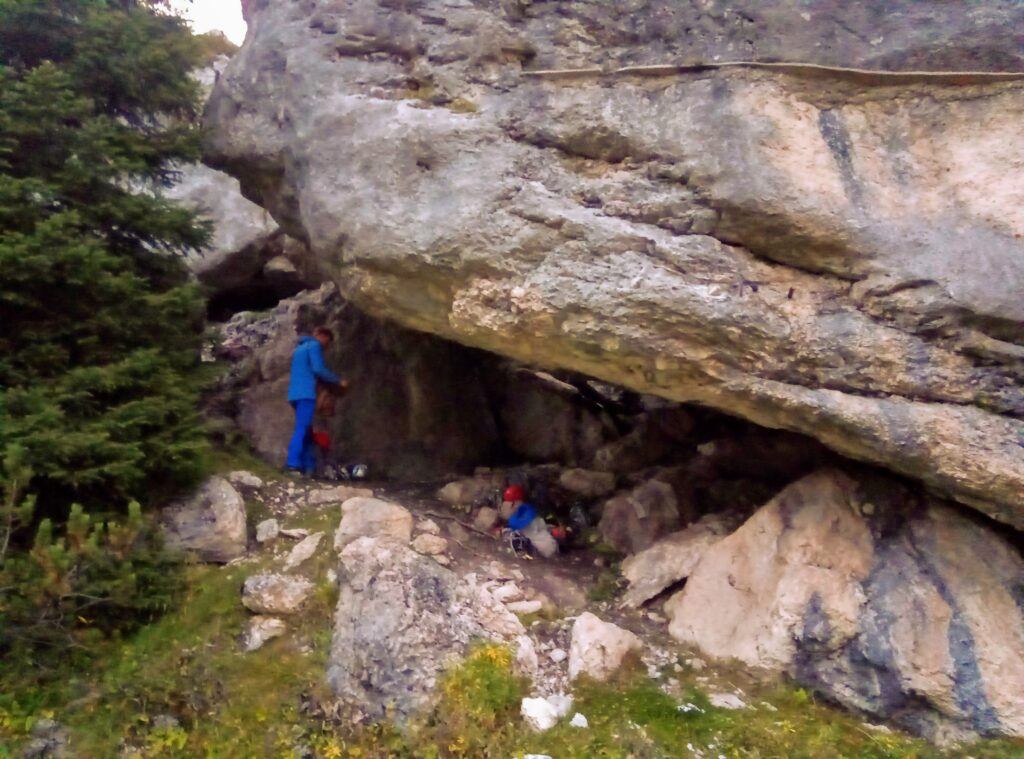
The next day we wake up at five in the morning with the title I wish you were here covered by Alpha Blondy, a piece of music that will become a kind of hymn for the rest of our trip. Instead of half an hour according to our overly optimistic estimates, it will take us almost an hour from our bivouac to reach the start of the route carefully spotted the day before. Is it still an approximation due to the immensity of these mountains?
The climbing then begins around 6.30 am at the first light of day. Max takes the lead and goes through the first 6 lengths of moderate difficulty with cleanliness and efficiency. The climb is fluid but difficult to protect, the irregular rock offers few proper placements for both our mechanical and passive jammers. So we take on a little more than usual, sometimes taking more risks. We don't like it very much, so we plant pitons, which is a first for both of us. And we understand better why it is reassuring on this type of wall to have a hammer and this type of equipment. Often the belays are made up of old pitons and they must be reinforced, either by tapping on the pitons in place, or by placing another point next to it as a reinforcement. It's also the first time I've climbed such a long multi-pitch route with such a heavy bag including my bivouac gear. Many firsts for this outing, you have to concentrate, get into it, immerse yourself in the minerality, dedicate yourself to 100% in the moment, in osmosis with the rock and my climbing partner. All thoughts are then turned towards the ascent, and if the mind sometimes wanders during moments of rest while the other is climbing, it is to better concentrate when it is necessary to regain a hold and read the gestural score that is draw above us.
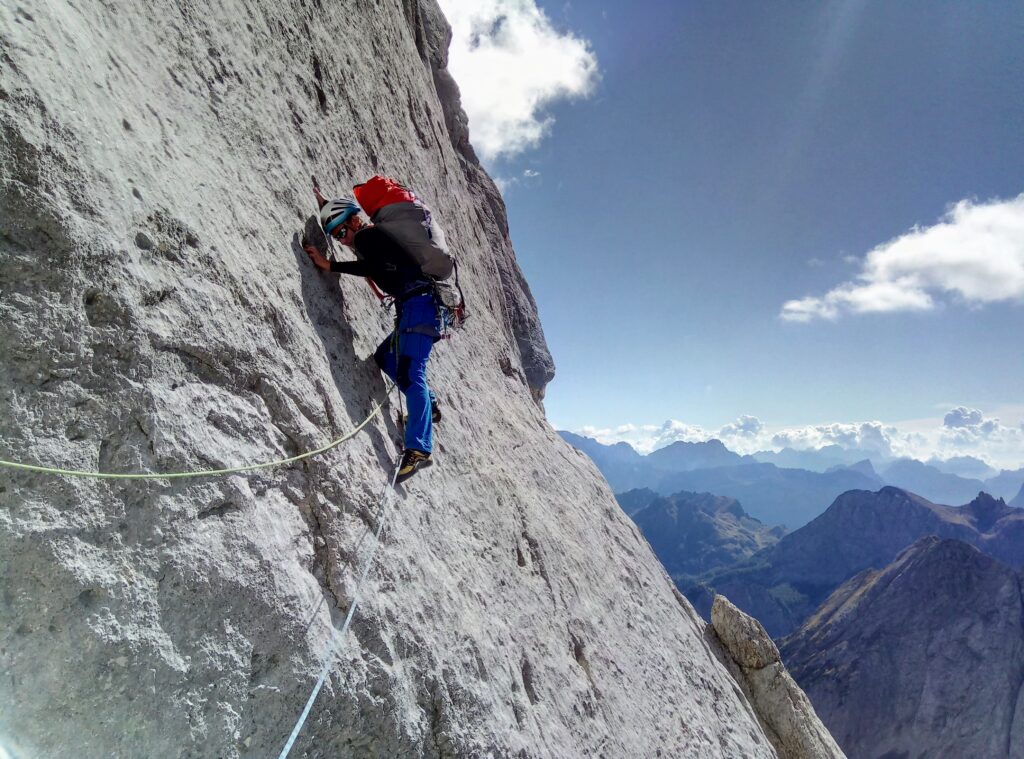
I take the continuation in a series of lengths a little more demanding which go up a technical dihedral. He will instil in us a deep respect for Vinatzer who passed through there in 1936 with much more rudimentary equipment than ours. Georges Livanos felt the same admiration during the 3rd repetition of this route in 1952. Here is how he describes this section in the story of his ascent, taken from his book Beyond the vertical :
“Above, a straightening of the slope coincides with the deplorable disappearance of the catches […]. The poor imagination of the sculptors who decorated this slab is hard to see. […] A helicoidal climb around a ridge brings me back to the dolomitic void. Between my feet, I can see the path traveled this morning! […] Definitely this Mr. Vinatzer had some knowledge of climbing!”
At midday we reach the large intermediate ledge on which we agree the first break together. This wide platform on which a bivouac must be very comfortable, protected from the rain and possible rockfall marks the end of the Vinatzer route and the start of the Messner variant.
Little ants attacking a giant, the hours pass and we relentlessly continue our ascent. The peaks are rarer on this second part and we are sometimes afraid of being lost. We regularly do long lengths of 60 meters and create our own belay because we cannot find the one indicated on our topo. It doesn't matter as long as we have enough confidence in our belay points and the pace of the ascent is not interrupted by unproductive searches. When we hesitate on the route to follow, we prefer to make a relay, think about the time that our second joins us while inspecting the topo. Very often the best solution imposes itself on us, and if this is not the case, we then decide together on the best direction to follow. And everything starts again without loss of time. Given the length of the ascent, the speed of progression is essential, guaranteeing our safety for the descent to come, which should ideally be done during the day and in clear weather. Unfortunately, we will not be entitled to either one or the other!
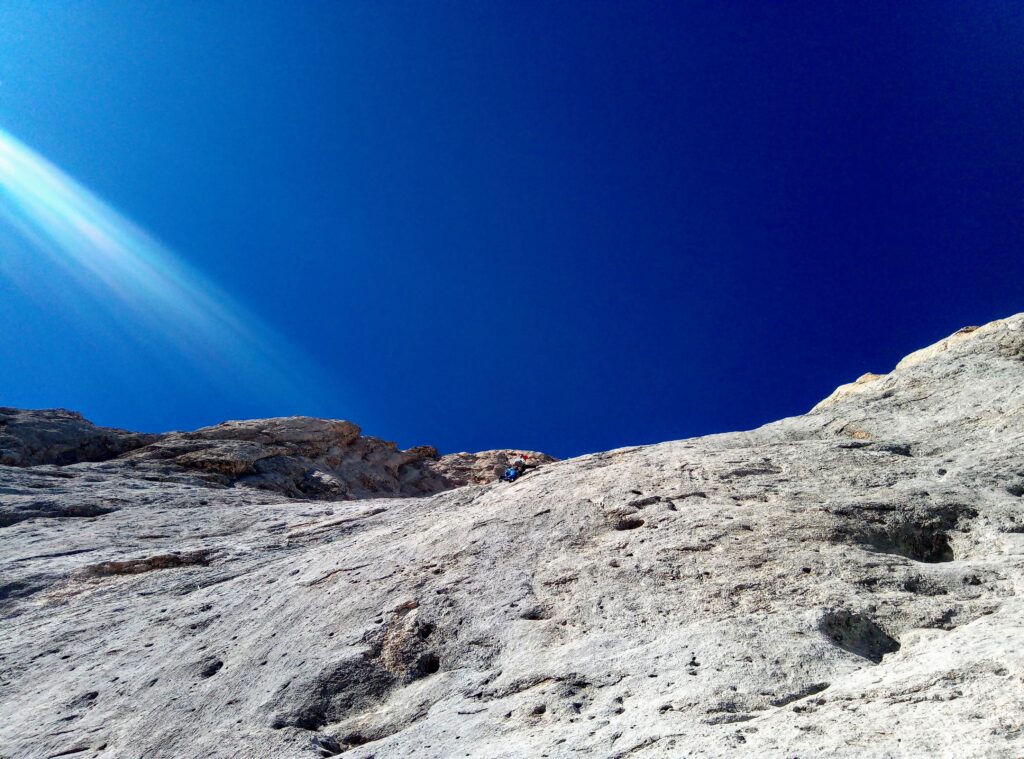
Two lengths before the summit, thick clouds come to cap the Queen of the Dolomites and it is in a thick fog that we go out at the top of Punta Rocca after 12h30 of climbing. It is then 7 p.m., which is a rather honorable time for a first in the Italian massif! Like two shipwrecked people joining the mainland, we are a bit stunned, stupefied after so much verticality to find ourselves again on a horizontal surface. We feel deep joy, enthusiastically proceeding to the ritual congratulations of the summit!
But there is only half an hour of daylight left, and the largest glacier in the Dolomites spreads out in front of us. The fresh snow that we tread on while putting away the equipment and nibbling on a few biscuits tells us that the Dolomites have not escaped the cold spell and the rains of early September. We have no crampons, ice ax or any safety equipment to progress on the glacier. The only map in our possession was collected free of charge from the Tourist Office and indicates the hikes in the region. The least we can say is that it is relatively imprecise as to the best way to cross the glacier to reach Passo Fedaia. Despite the last light of day, the fog prevents us from having an overall view which would indicate the path to follow. In addition, the efforts made during the day begin to weigh, both from a physical and mental point of view. The lights are clearly not all green.
To the fatigue of a short night in bivouac and a demanding ascent of 900 meters, there is therefore a descent at night and in the fog to be taken seriously. We enter the glacier, sometimes sinking painfully up to our knees. We are not roped together, because without an ice ax or crampons, the fall of one would inevitably lead to the fall of the other. Max wants to descend directly and I prefer to follow the top of the glacier towards the East, in order to find the cabin of the Funivia Marmolada and possibly bivouac there for the night in order to descend the next morning. Visibility is still very poor, but the weather does not seem to be deteriorating.
The lyrics of the song I listened to when we woke up come to mind:
We're just two lost souls
Swimming in a fish bowl
The soft snow warmed up during the day still allows us to make good progress despite the misty darkness that surrounds us. Finding the cabin of the Funivia was finally a wise choice because we find there many tracks that descend from the glacier towards the desired direction. We then let ourselves be carried away by the slope of snow and ice. We still breathe a sigh of relief when our shoes find a rocky ground, devoid of ice. Two hours later, here we are at Passo Fedaia, and all the tension of the day falls. We are safe and sound, happy to have climbed the south face of the Marmolada and to have come down from the glacier without fear despite our ignorance of the place, our lack of equipment, fatigue, the fog and the night.
Nevertheless, we are still a good ten kilometers from our car, and the road in front of us is not the busiest. We plan to bivouac on this pass when suddenly a car arrives, I then rush to the edge of the road, waving my thumbs and arms. In the middle of the night, the driver must have thought I was crazy, I felt him hesitate, slow down, and finally stop! Jubilation! They are a couple of local climbers who we enthusiastically tell about our adventures of the day and they bring us directly to our base camp, in the parking lot of Malga Ciapela. What luck !
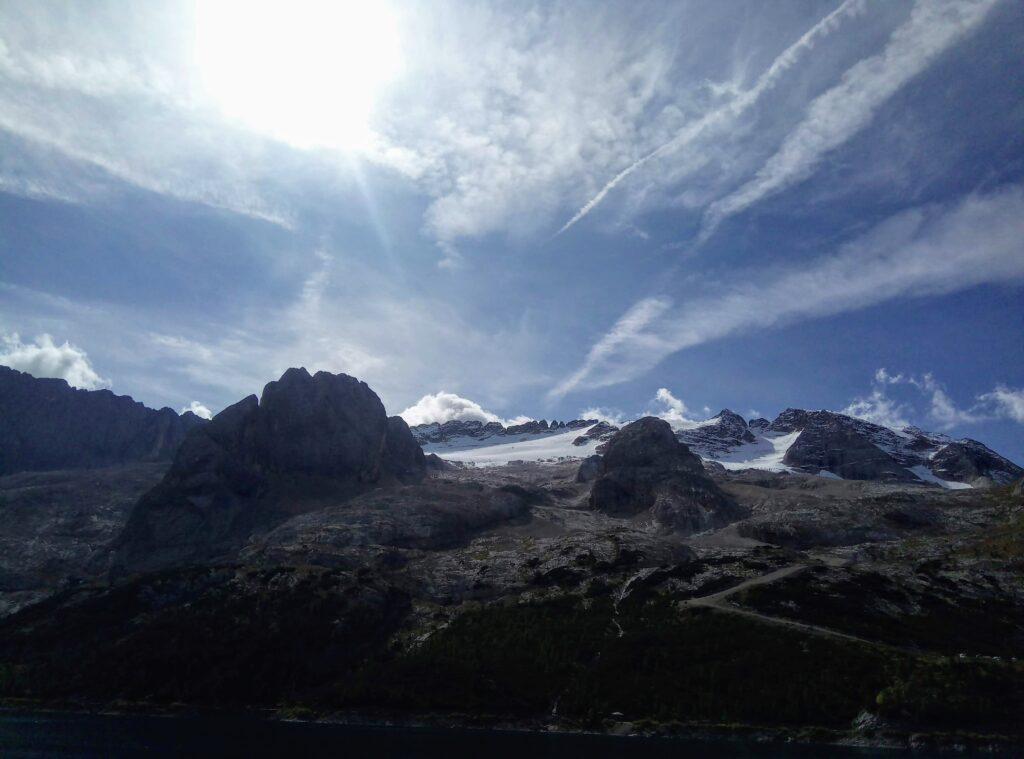
With this tremendous helping hand from fate, the Marmolada adventure ends, laying the ambitious milestones for a trip to the formidable peaks of the transalpine massifs.


